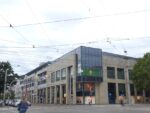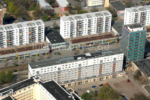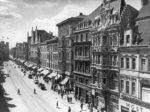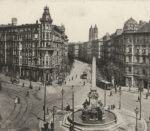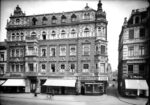The city of Magdeburg, deep in Germany’s equivalent of fly-over states in the U.S. is an odd mixture: a few showstopper architectural highlights of truly global signficance, a few pockets of liveliness, a great deal of ugliness, and next to no charm. Here I will show the bucket-list essentials that every architecture fan needs to know about, plus a few fascinating odds and ends
Magdeburg was 90% destroyed in World War II which of course means only 10% of the buildings are from before 1950 or so. Walking around you would hardly know Magdeburg is over 1,200 years old and was gloriously, opulently beautiful and prosperous before the war. The oldest documentation of the city is from 805 (805, not 1805) and a few decades later it was a center of power of the Holy Roman Empire. Today, the Neonazi party has 14% of the seats on the city council and 25% in the parliament of the state of which Magdeburg is the capital, Saxony-Anhalt.
Nowadays most of it looks like this…
Whereas it looked like this before the war…
Here are three churches that are around 800 years old with a highway running just a few feet away. 
Yet there are plenty of large, well-maintained parks containing a couple of beautiful historic buildings close to the city center (which I didn’t get to see), and this spectacular complex with apartments, shops, cafes, a hotel, theater, and winding roof gardens by the extravagantly eccentric, sometimes inspired and sometimes kitschy artist-architect Friedensreich Hundertwasser (1928-2000, a pseudonym meaning Kingdom-of-Peace Hundred-Water, a pun on his original last name), constructed posthumously in 2005.
This department store is actually a rarer and more special treasure, because whereas there are about 25 buildings by Hundertwasser in the world, this is the only intact example of a series of spectacular futuristic modernist department stores built in Germany in the 1960s and 70s. Their facades consisted of aluminum panels in geometric space-age honeycomb patterns, different for each store. These were all in the former Communist East Germany; a chain in the West called Horten had similarly dramatic, space-age designs using white glazed ceramic blocks (not pictured). All the stores in both east and west were torn down in the 2000s, apart from the one in Magdeburg, in a merciless wave of demolition of midcentury-modern treasures large and small (think Mad Men, or Jetsons, or World’s Fairs of the 50s and 60s) that swept the country- almost Taliban-like in its contempt for history, beauty and humanist values – and is still going on.
Nothing of the original interior of hte Magdeburg store remains. Of the stores that were demolished, two had their facades rebuilt in the 2010s, fairly faithfully, but covering unrelated and altogether sterile featureless new buildings.
The one in Leipzig had a bizarre and preposterous history. It was demolished in 2010 but the panels were rescued and used on the exterior-only re-creation of the building from 1968. This is where the bizarre and preposterous part begins. The original building was in fact not even a building at all, but an almuninum facade built in 1968 to cover up the actual original building, which was from 1908 and had survived two world wars largely intact. In 2010 the panels were removed and the landmarked building from 1908 torn down apart from one 50-foot piece of wall which still survives behind the reinstalled aluminum facade but is visible neither from inside nor out. So no one will ever be able to see it. The authorities, in a move beyond any Newspeak that Orwell could imagine, ruled this this as compliant with the landmark preservation laws .
This obscene mockery of historic preservation caused an uproar. A citizens’ movement had called for the 1968 facade to be relocated to the other side of the building and the 1908 building to be restored. This would have been a glorious contribution to the cityscape given that 60% of Leipzig was destroyed in World War II. The authorities refused.
The cloister dating back to the 1100s has beautiful and striking mirror-polished metal shutters. It is now a contemporary art museum that appears to be of high quality although I didn’t have time to go in. When I asked a question, the woman at the ticket counter was rude and cranky so even if I had had time it would have soured the experience.
Cities and towns all over Germany installed a great deal of excellent public art throughout the 1950s and 60s. A lot of it has been demolished or put into permanent storage starting in the 1990s but a fair amount is still in place. Although both the former West and East Germany had great public art, I have seen more of it and better quality in the East. I don’t know whether that’s because the West has gotten rid of more of theirs while the East has preserved it, or because the East had more and better to begin with.
The titles of these panels are phrased in the manner of signs on shops and inns from past centuries, such as “At the Sign of the White Lion” and “At the Sign of the Golden Trumpet” but I have no idea what any of it is referring to.
I thought this relief picturing someone falling off a building and being caught by a person down below had some sort of metaphorical artistic meaning until I read the text. It’s not a metaphor but rather, it literally depicts the time a Soviet army captain caught a 4 year old girl in his coat when she fell from a sixth story window in 1969.
An odd and quirky collection of people and events are depicted on the doors to the city hall. They all are important figures in the city’s history but the juxtaposition is so delightfully incongruous it feels like it could be from a Monty Python sketch. The photos show…
- Till Eulenspiegel, much-loved, wise trickster figure in German folklore
- Doctor Eisenbart, figure from a popular song of the 1800s that is still well-known, based on a real-life doctor from the 1600s
- Otto von Guericke (1602-1686), inventor of the vacuum pump, major figure in the history of physics, mayor, and city hero. If you’ve ever seen the old engraving of horses trying to pull apart a giant sphere – he invented that. It’s two metal half-spheres with the air sucked out and is known as the Magdeburg hemispheres.
- Georg Phlipp Telemann, baroque composer
- Reconstruction of Magdeburg after World War II
- Soviet-Realist allegory of young girl giving flowers to an official
- Women rebuilding the destroyed city after the war. The women are taking bricks from a collapsed building and passing them to a bricklayer. Millions of women helped clear rubble in this way throughout in Germany because so many men had died. I have heard conflicting reports on whether they volunteered or were forced.
I’ve saved the most important for last, because I didn’t get to see it. Magdeburg has one of the world’s largest concentrations of early-modern and Bauhaus-era buildings from the 1920s and they mostly have protected landmark status and good, faithful restorations. The great expressionist/modernist architect Bruno Taut was city planner in the 1920s. However most of the buildings are widely scattered in the suburbs and aren’t easy to reach without a car so here are a few photos from the internet.

